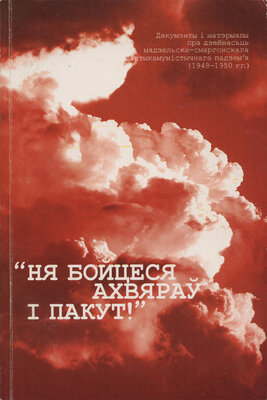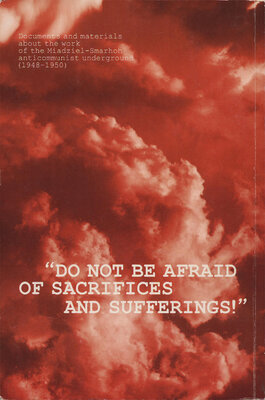Ня бойцеся ахвяраў і пакут!
Міхась Чарняўскі
Выдавец: Наша Будучыня
Памер: 175с.
Вільня 2006
In a postwar decade the regional courts, at that time there were 12 of them, tried several dozens of political cases. Military tribunal worked uninterruptedly. The charges were alike: antiSoviet propaganda, antiSoviet books or arms keeping, participation in the antiSoviet partisan movement or assistance in it, participation in the organizations which aim was to “abolish the soviet rule, separate Belarus from the USSR and turn it into a bourgeois country”.
The largest anticommunist organizations were eliminated by the
128
punitive bodies in the first postwar years. However later there were the people, again and again, especially among the youth, who united for the sake of fighting for freedom and democracy. Among them the leading role belonged to the MiadzielSmarhon underground movement of the studying youth (19481950).
At the beginning of 1948 the illegal pupils’ organization appeared in the Miadziel secondary school. Its founder and ideologist was the 8th former Rascislau Lapicki (01.09.1928 27.10.1950) a staunch anticommunist and Belarusian patriot, who had already had the experience of the underground work among the youth of the southeastern Vilnia region. Apart from Lapicki, the active members of the Miadziel organization were the pupils Juzaf Kacerha and Hienadz Nafranovic, as well as Fakunda Niesciarovic, who after finishing the 7th form studied in Miensk polytechnic. All in all there were up to dozen lads and lasses and young men from the nearby villages and the Kabylnik borough (now the village Narac of the Miadziel district).
The members of the underground met in Miadziel, sometimes in the nearby Mikasiecak, home of Lapicki. Their activity was to a greater extent limited to the verbal anticommunist propaganda. R. Lapicki made a receiver with the help of which they got information from the western radio stations about the international climate and then spread it among the classmates and local peasants. At the same time they made leaflets on the printing machine owned by J. Kacerha and distributed them in Miadziel and surrounding villages. The leaflets were prominent for their anticommunist radicalism:
“Death to the degenerates of the mankind!
Partisans!
The underground members!
Defend your cause! Nurture the sacred hatred against the communism, which mutilates and corrupts the mankind! Fight against Stalin jackals!
Youth!
Do not lose the conscience, fight against those who put absolute trust in the deception of communism headed by the Christbetrayers. They want to crucify us on the fivepoint star.
129
To arms! Do not be afraid of sacrifices and sufferings!
Ahead to the bright future!
Your brothers”
The underground members prepared for the imminent war with the western democracies and the expansion of the anticommunist partisan movement and therefore planned more aggressive activities there were found arms and explosives during some searches at the beginning of 1950.
In autumn 1949 R. Lapicki together with his mother moved to Smarhon escaping from hunger and destitution. He entered the 10th form of the local school and here as well actively started to form the anticommunist organization. That was encouraged by the atmosphere of the active and passive resistance that prevailed in that region.
The underground movement united about a dozen and a half of lads and lasses, the majority of whom were the pupils of the 7th10th forms from Smarhon and the nearby villages as well as some older citizens. The anticommunist agitation was held during the school recesses, evening parties, in the club, where Lapicki earned by playing the piano. And the underground members met most often in the house of the Cybotiskis whose children were the active participants of the organization. R. Lapicki could get a printing machine and a supply of carbon paper. This made it possible to organize the mass printing of the leaflets by at the Achramovicis estate near the Carniaty village.
The ties with the Miadziel part of the underground movement were not lost. They were realized through Fakunda Niesciarovic and Rascislaft Lapicki himself who visited his likeminded friends in the Narac region.
The end of 1949 saw the peak of the activity of the Smarhon organization. On the eve of the “Stalin constitution” day the underground members prepared many leaflets, which were posted at night on road posts, house walls and fences, even on the buildings of the Party’s district committee and police. The leaflets urged the population not to pay taxes, not to enter kolkhozes, to organize resistance against the regime. Every leaflet ended with the words: “Death to Stalin!”. Moreover the underground members prepared to blow up the building of the regional printinghouse.
130
After the first distribution of the leaflets in the town plenty of security service officers and military men came to town, the twentyfourhour watch over the streets was introduced. The search for the action participants began. It wasn’t hard to trace the underground members. Too young, some of them were underage, they didn’t know all the conspiracy secrets, and many people at school suspected the existence of the organization.
Rascislau was arrested in December. Punitive bodies not having obtained the evidence released him temporarily. According to the organization’s resolution the leader had to acquire illegal status and leave the town. And Lapicki secretly moved to the Miadziel region.
On the night of February 2,1950 the representatives of the Ministry of National Security made an ambush in the house of the Cybodskis. They arrested everyone who came; some of the underground members were caught. In February March 1950 the number of the arrested grew up to 20 including some from the Miadziel region. Hienadz Nafranovic, the member of the Miadziel organization from Juskavicy, shot himself during the attempted arrest. Rascislau Lapicki was arrested in the conspiracy flat in Kabylnik.
The arrested underground members were kept in Vialiejka and Maladziecna prisons. Investigators were unmercifully brutal during the interrogations; the most cruel among them was some Pakhomov. Lads suffered most of all. The investigators smacked their teeth, broke ribs, drove needles under nails, made them sit on the bench legs, held them under the drops of cold water up to madness, and applied other wildest perversities.
The trial of the Military tribunal of the Belarusian military district was held in Maladziecna on the 17th20th of July 1950. Almost all the accused behaved courageously. The most undefeated was Rascislau Lapicki. His final plea was the accusation of the inhuman regime. Being sentenced to be shot he refused to submit an appeal.
The court of the Military tribunal sentenced the following people:
Lapicki Rascislau death penalty,
Niesciarovic Fakunda death by shooting substituted by the 25 years’ imprisonment,
Achramovic Zianon 25 years’ imprisonment,
131
Achramovic Auhuscin 25 years’ imprisonment,
Achramovic Hanna 25 years’ imprisonment,
Blizniuk Vosip 25 years’ imprisonment,
Karniej Anatol 25 years’ imprisonment,
Kacerha Juzaf25 years’ imprisonment,
Lapycka Sofija 25 years’ imprisonment,
Staskievic Eduard 25 years’ imprisonment,
Chacilouski Tadevus 25 years’ imprisonment,
Cybouskaja Lieakadzija 25 years’ imprisonment,
Cybouski Caslau 25 years’ imprisonment,
Juskievic Tamara 25 years’ imprisonment,
Juskievic Taciana 10 years’ imprisonment,
Ivanouski Kanstancin10 years’ imprisonment,
Paskievic Zbihnieu10 years’ imprisonment.
Earlier, in May of the same year, the Maladziecna Regional Court sentenced the following persons for “non information”:
Asukotiskaja Caslava 8 years’ imprisonment;
Bartasevic Maryja 10 years’ imprisonment.
Juzaf Kacerha told about the last minutes of the MiadzielSmarhon leader according to Fakunda Niesciarovic, who came back from the Stalin concentration camps:
“At an autumn night Rascislau Lapicki and Fakunda Niesciarovic were brought to the forest near Vialiejka. They were brought to the dug out pit and placed side by side. The verdict to Fakunda’s shooting was read. And immediately after that the decree of the Presidium of the Supreme Soviet of the USSR about his pardon. The same verdict of death by shooting was read to Rascislaft. However the decision of his pardon was not announced. Yet there was one for Lapicki. Nevertheless he, while yet in prison, refused flatly an unasked kindness. The shot banged and the lad fell down. The soldiers filled up the pit quickly...”
Not all the participants of the underground movement ended up in the torture chambers of the Ministry of National Security. Some of them were successfully hidden. Even more so the punitive bodies didn’t find any lists of organization friends.
The accused served their sentences in concentration camps in Siberia and Kazakhstan, at loggings and construction sites, in mines
132
and pits. The underage were kept in special children colonies. After the Stalin death the former underground members were released in mid 1950s. After the return from imprisonment some stayed in the fatherland, some went to Poland, Lithuania, Russia. Tortures and penal servitude left grave traces more than half of them are already deceased.
The participants of the MiadzielSmarhon underground movement were true faithful Christians Catholics and Orthodox, the majority of them had explicit national selfconsciousness Belarusian or Polish, however they all were united and inspired by the struggle with the communist occupation regime.
BIOGRAPHIES
Achramovic Aiihuscin (1882, v. Carniaty of the Smarhon region 1976, Elblong, Poland).
Peasant from khutor near Carniaty near Smarhon, the father of Zianon. In autumn 1949 assisted the Smarhon underground members in anticommunist leaflets printing, gave them room at khutor for that purpose. Was arrested at the end of March 1950 and was sentenced the same summer to the 25 years’ imprisonment. Served the sentence in camps of the Miensk and Habarovsk regions. Was released in 1955, returned to Carniaty. Later moved with family to Poland.
 КНІГІ ОНЛАЙН
КНІГІ ОНЛАЙН


